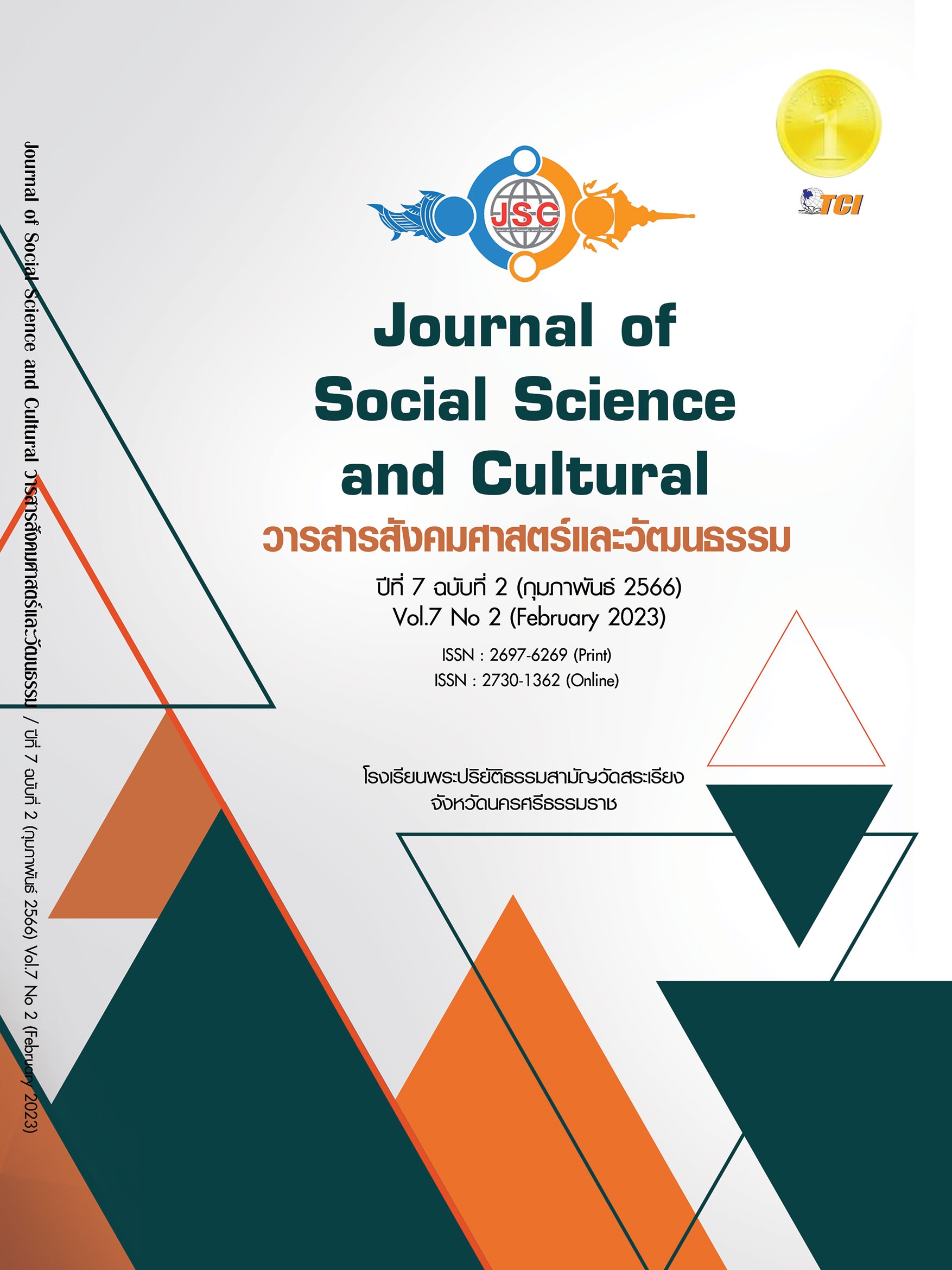COMMUNICATION MODEL TO ESTABLISH COLLABORATION AMONG STAKEHOLDERS OF COMMUNITY POWER PLANT FOR FOUNDATION ECONOMY PROJECTS IN NORTHERN THAILAND
Main Article Content
Abstract
The objectives of this research were to study: 1) A communication model to create cooperation between the public and private sectors, communities, and entrepreneurs with communities. 2) Guidelines for the development of the communication model of entrepreneurs with communities that affect cooperation in community power plant projects. This was mixed-method research through qualitative research and quantitative research. Key informants were 10 people from government personnel, the private sector, and community leaders, using purposive selection. The sample group were 406 people in the area of the community power plants project using multistage random sampling. The research tools were semi-structural interview forms and a questionnaire. Qualitative data were analyzed by the descriptive analysis method while quantitative data were analyzed by the mean and standard deviation analysis methods. The hypothesis testing used multiple regression analysis. The result showed that the communication model to create collaboration between the public and private sectors and communities and entrepreneurs and communities was face-to-face communication, one way and two ways through the seminar forum. By presenting policies and impacts, both positive and negative, of the community power plant establishment. And that communication affects knowledge and understanding of community power plants at a high level, = 3.95. The guideline to develop the communication style of entrepreneurs that affects cooperation is to develop content and sender skills by using language suitable for the area. And hypothesis testing, it was found that participation and acceptance influenced community power plant cooperation at statistical significance at the .01 level. While the collaboration in the activity of community power plant project = -.067+.554 (participation) + .304 (accept)
Article Details
References
กฤชศุลี ทองเนียม. (2559). การสื่อสารเพื่อสร้างการยอมรับจากผู้มีส่วนได้ส่วนเสียในโครงการพัฒนาโรงไฟฟ้าขนาดใหญ่ในประเทศไทย. ใน ดุษฎีนิพนธ์ปรัชญาดุษฎีบัณฑิต สาขานิเทศศาสตร์. มหาวิทยาลัยสุโขทัยธรรมธิราช.
การไฟฟ้าฝ่ายผลิตแห่งประเทศไทย. (2562). เวทีเสวนา “ชวพน. ชวนคุย ตอน โรงไฟฟ้าชุมชน ประชาชนได้อะไร”. เรียกใช้เมื่อ 10 ตุลาคม 2565 จาก https://www. egat.co.th/index.php?option=com_content&view=article&id=3147:mis-20190920-01&catid=30&Itemid=112
นูรีดา ตาเยะ และ คณะ. (2562). ความรู้ ความเข้าใจ ปัญหาการดำเนินโครงการโรงไฟฟ้า และแนวทางการมีส่วนร่วมของชุมชนกับการแก้ปัญหาความขัดแย้ง: กรณีศึกษา โรงไฟฟ้าถ่านหินตำบลปากบาง อำเภอเทพา จังหวัดสงขลา. ใน เอกสารการประชุมวิชาการด้านมนุษย์ศาสตร์และสังคมศาสตร์ระดับชาติ ครั้งที่ 2 "มนุษย์ศาสตร์และสังคมศาสตร์ นวัตกรรมสร้างสรรค์สังคม" (หน้า 117-132). สงขลา: มนุษย์ศาสตร์และสังคมศาสตร์ มหาวิทยาลัยราชภัฏสงขลา.
พนิตา เจริญสุข และคณะ. (2557). การศึกษาปัจจัยที่มีผลต่อการร้องเรียนด้านผลกระทบต่อสิ่งแวดล้อมและสุขภาพจากการดำเนินการโรงไฟฟ้าชีวมวล (ปัจจัยสำคัญที่ทำให้สถานประกอบการอยู่ร่วมกันกับชุมชนอย่างยั่งยืน: กรณีศึกษาโรงไฟฟ้าชีวมวล). ใน รายงานการวิจัย. กองประเมินผลกระทบต่อสุขภาพ กรมอนามัย กระทรวงสาธารณสุข.
พีรภพ จอมทอง. (2559). การศึกษาปัจจัยที่มีผลต่อความสาเร็จของโรงไฟฟ้าชีวมวล. ใน วิทยานิพนธ์ปริญญาวิศวกรรมศาสตรมหาบัณฑิต สาขาวิชาการจัดการงานวิศวกรรม. มหาวิทยาลัยศิลปากร.
วัฒนพงษ์ คุโรวาท. (2564). สถานการณ์พลังงานปี 2563 และแนวโน้มการใช้พลังงานในปี 2564. เรียกใช้เมื่อ 15 พฤศจิกายน 2565 จาก https://re-fti.org/สนพ-คาดความต้องการใช้ไฟ/
สำนักงานเลขาธิการคณะรัฐมนตรี. (2562). คำแถลงนโยบายคณะรัฐมนตรี: พลเอกประยุทธ์ จันทร์โอชา นายกรัฐมนตรี แถลงต่อสภานิติบัญญัติแห่งชาติ. กรุงเทพ: สํานักพิมพ์คณะรัฐมนตรีและราชกิจจานุเบกษา.
สำนักงานปลัดกระทรวงกลาโหม. (2557). กรอบความเห็นร่วมการปฏิรูปประเทศไทยด้านพลังงาน. กรุงเทพมหานคร: คณะรักษาความสงบแห่งชาติ.
อดิศักดิ์ ชูสุข. (9 กันยายน 2565). รูปแบบการสื่อสารเพื่อสร้างความร่วมมือกับผู้มีส่วนได้ส่วนเสียโครงการโรงไฟฟ้าชุมชนเพื่อเศรษฐกิจฐานรากในเขตภาคเหนือของประเทศไทย. (วิศิษฎ์ เกตุรัตนกุล, ผู้สัมภาษณ์)
อัครเดช เนตรสุวรรณ. (2561). ยุทธศาสตร์การสร้างความร่วมมือของชุมชนเกิดใหม่เพื่อการพัฒนาท้องถิ่นขององค์กรปกครองส่วนท้องถิ่น จังหวัดปทุมธานี. วารสารวิจัยราชภัฏพระนคร สาขามนุษยศาสตร์และสังคมศาสตร์, 13(2), 207-222.
อุสาร์ ดวงจันทร์. (20 กันยายน 2565). รูปแบบการสื่อสารเพื่อสร้างความร่วมมือกับผู้มีส่วนได้ส่วนเสียโครงการโรงไฟฟ้าชุมชนเพื่อเศรษฐกิจฐานรากในเขตภาคเหนือของประเทศไทย. (วิศิษฎ์ เกตุรัตนกุล, ผู้สัมภาษณ์)
Berlo, D. K. (1960). The Process of Communication. New York: The Free Press.
Cochran, W. G. (1977). Sampling Techniques. (3rded.). New York: John Wiley & Sons.
Delbecq, A. L., et al. (1975). Group techniques for program Planning: A guide to nominal group and Delphi processes. Glenview, IL: Scott: Foresman and Company.
Everett, M. R. (2003). Diffusion of Innovation. (5thed.). Avenue of the Americas New York, New York: A Division of Simon & Schuster, Inc. 1230.
Vangen, S. & Huxham, C. (2013). Building and Using the theory of Collaborative Advantage. In Keast, R., Mandell, M. P. & Agranoff, R. eds. Network Theory in the Public Sector: Building New Theoretical Frameworks (pp. 51-69). New York: Routledge.
White, S. A. (1993). Participatory Communication for Social Change. New Delhi: Sage Publications.


